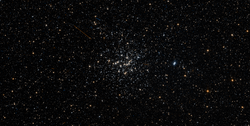| NGC 1943 | |
|---|---|
 Hubble Space Telescope photograph of NGC 1943 | |
| Observation data (J2000.0 epoch) | |
| Right ascension | 05h 22m 28.7s [1] |
| Declination | −69° 20′ 07″ [1] |
| Apparent magnitude (V) | 11.9 [2] |
| Physical characteristics | |
| Associations | |
| Constellation | Mensa |
NGC 1943 is a star cluster in the constellation Mensa. It was discovered in 1826 by the astronomer James Dunlop with a 23-cm telescope. [3]